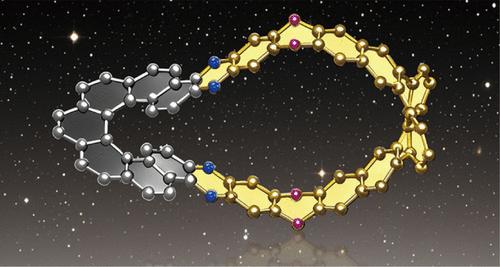A Writhed Möbius Nanobelt Derived from [7]Helicene
IF 15.6
1区 化学
Q1 CHEMISTRY, MULTIDISCIPLINARY
引用次数: 0
Abstract
A novel writhed Möbius nanobelt was synthesized using a helical building block derived from [7]helicene and a C-shaped building block derived from pyrene. These two building blocks were connected through nucleophilic aromatic substitution to form an oxanorbornene-containing macrocycle, which was then converted to the nanobelt by reductive aromatization and subsequent oxidation. The structure of the Möbius nanobelt was confirmed with X-ray crystallography. Both the nanobelt and its macrocyclic precursor exhibit C2 symmetry, but this symmetry is only reflected by the 1H NMR signals for the tetra(4-t-butylphenyl)dinaphthopyrene moiety in the nanobelt, not in its precursor. This difference is attributed to the distinct arrangements of the pendent 4-t-butylphenyl groups, caused by the crowdedness and restricted rotation of the C–C single bonds in the nanobelt. Theoretical calculations suggest that the nanobelt does not exhibit global ring currents but has localized aromatic ring currents. Additionally, when an enantiopure form of the [7]helicene derivative was used, the nanobelt was obtained in an enantiopure form, showing an absorption dissymmetry factor of 4 × 10–3.

由[7]螺旋烯衍生的卷曲Möbius纳米带
以[7]螺旋烯为螺旋结构单元,以芘为c形结构单元,合成了一种新型卷曲Möbius纳米带。这两个结构块通过亲核芳香取代连接,形成含氧生冰片烯的大环,然后通过还原芳构化和随后的氧化转化为纳米带。用x射线晶体学证实了Möbius纳米带的结构。纳米带及其大环前驱体均表现出C2对称性,但这种对称性仅在纳米带的四(4-t-丁基苯基)二萘部分的1H NMR信号中反映出来,而在其前驱体中则没有。这种差异是由于纳米带中C-C单键的拥挤性和受限旋转引起的4-t-丁基苯基的不同排列。理论计算表明,纳米带不具有全局环电流,而具有局部芳香环电流。此外,当使用[7]螺旋衍生物的对映纯形式时,得到的纳米带为对映纯形式,其吸收不对称系数为4 × 10-3。
本文章由计算机程序翻译,如有差异,请以英文原文为准。
求助全文
约1分钟内获得全文
求助全文
来源期刊
CiteScore
24.40
自引率
6.00%
发文量
2398
审稿时长
1.6 months
期刊介绍:
The flagship journal of the American Chemical Society, known as the Journal of the American Chemical Society (JACS), has been a prestigious publication since its establishment in 1879. It holds a preeminent position in the field of chemistry and related interdisciplinary sciences. JACS is committed to disseminating cutting-edge research papers, covering a wide range of topics, and encompasses approximately 19,000 pages of Articles, Communications, and Perspectives annually. With a weekly publication frequency, JACS plays a vital role in advancing the field of chemistry by providing essential research.

 求助内容:
求助内容: 应助结果提醒方式:
应助结果提醒方式:


